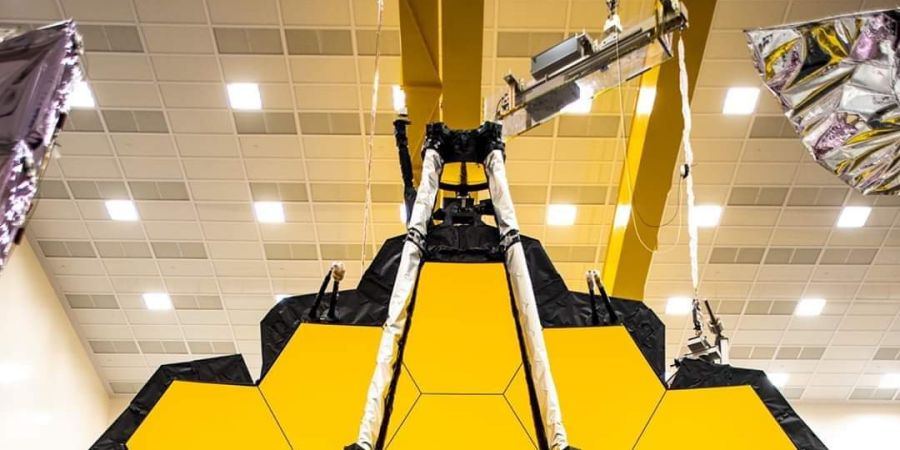

Are we alone in the universe?
Could the phenomenon of life have originated elsewhere and arrived here on Earth? Are there other places in the universe where life exists—planets suitable for us to live on? How does the universe work? The James Webb Space Telescope is NASA's ambitious scientific effort to answer these questions in collaboration with the European and Canadian space agencies.
Hubble's successor, the Hubble Spitzer Space Telescope, is a telescope with more precision and sensitivity—that's James Webb. It is the largest, most powerful and most complex telescope ever launched into space. The telescope was launched on 25 December 2021 from Arianespace's ELA-3 launch complex at the European Spaceport near Kourou, French Guiana. The launch was on the Ariane 5 rocket, one of the world's most reliable launch vehicles.
The launch vehicle is part of the European contribution to the mission.
The world of science believes that the universe was formed in the big bang that happened about 13.8 billion years ago. The main mission of the Webb Telescope is to observe what happened in the early universe after the Big Bang. That observation will include the formation of the first galaxies and the birth of the first stars. This new telescope will help us understand what happened to stars 250 million years after the Big Bang. It can also observe the behavior of gas and dust around stars. Also the nature of the light of these stars can be known. The web can help us find black holes, stars, and planets in galaxies, explore cool dark regions in the solar system like the Kuiper Belt, and learn about the origins of life.
Webb will also specifically observe the asteroid K2-141b, located 202 light-years from Earth. This asteroid is unique in that it is the only melting asteroid found in the universe. The nature of its minerals will also be examined. A great advantage is that the Web telescope works equally well in visible light and infrared. Often, light from planets and stars is absorbed by thick layers of dust. Infrared can pass through it. The web can capture these and provide us with information beyond the dust. It will be very helpful to study the redshift of cosmic matter.. Thus the web will show us many unknown and unusual views of this great universe. Webb will capture images of stars and planets billions of light-years away with an infrared camera and send them back to Earth. With the help of computer they will be made into pictures.
The Web Telescope is a super telescope in every sense. Webb's main mirror is six times larger than Hubble's main mirror. Hubble's is 2.4 meters across, while Webb's is 6.5 meters across. This is the largest size of the main mirror of a space telescope ever. A mirror this large has never been launched into space. It was difficult to fit such a large glass block into the telescope, so it was made possible by dividing it into 18 hexagonal sections and fitting them together precisely. All eighteen segments combine to focus distant objects into a single image. Each has a diameter of 1.32 m.
They are made of beryllium. There are many reasons for that. First of all, this telescope will operate in the extreme cold of space. Beryllium does not undergo significant deformation even at very low temperatures. It can withstand large variations in temperature. Secondly, it can be polished to a very fine finish. Thirdly, being a low molecular weight element, it also has a very low density. Much lighter weight will make space travel easier. Gold is also coated over the beryllium to make the reflection of light more efficient. The thickness of the coated gold is only 100 nanometers. So less than 50 grams of gold was used for the entire mirror. A thin layer of glass is also placed on top of the gold layer to protect it from scratches. The second mirror of the web has a diameter of 0.74 m. Even Spitzer's primary mirror is only 0.85 meters in size.
The web is a collection of many amazing technologies. Lightweight mirrors, coatings, actuators, mechanisms, electronics and thermal blankets. The web was designed to form an exact mirror when folded into an origami model, embedded in a rocket, and fully deployed after reaching space. The biggest feature of the James Webb telescope is its sun shade. It is about the size of a regular tennis court and is made of 5 layers. This is equivalent to using one million sunscreens. There is empty space between each layer. These layers protect the telescope from the scorching heat of the sun. These layers help to keep infrared radiation measuring instruments at temperatures below zero degrees and 223° Celsius. Web telescopes will work best at this temperature.
The Hubble telescope is located at a distance of 570 km from Earth. But James Webb's position is 15 lakh kilometers from Earth. After launch, Webb took about 30 days to reach its designated orbit. In the first three days, it traveled as far as the Moon's orbit. It does not orbit the Earth like Hubble, but orbits the Sun at a point that crosses the Moon.
This point where the gravitational forces of the Sun and the Earth neutralize each other is known as the second Lagrangian point.
L1, L2, L3, L4 and L5 are the 5 Lagrangian positions of the Earth-Sun system. Suppose an object standing in any of these positions revolves around the Sun with the same angular velocity as the Earth.; The resultant force of the gravitational forces exerted by the Sun and the Earth on it is equal to the centripetal force required to revolve around the Sun. Then it will always be at the same distance from Earth. These are ideal locations for setting up telescopes and stations for cosmic observation. Like the Earth, other planets have Lagratian positions with the Sun.
In 1993, Hubble faced some technical problems. The problem was solved by sending a special spacecraft from Earth. But, if the James Webb Telescope has a technical problem, it will not be able to be fixed for a while. When the Hubble telescope was broken and he went there and repaired it, it would not have happened here. NASA says it has no plans to send humans or robots that far in the next decade.
The James Webb Space Telescope has been hailed as one of the great scientific endeavors of the 21st century. The web is an amazing feat of human intelligence. Webb's story is one of perseverance and sacrifice. The mission has contributions from thousands of scientists, engineers and other professionals from 14 countries across nine different time zones.
Surviving many obstacles like earthquakes, devastating cyclones, snowstorms, wildfires, Covid19; Its construction was successfully completed with great care.
In 1996, the James Webb Space Telescope project was approved in principle. The project was then known as the Next Generation Space Telescope. The space agencies NASA, European Space Agency and Canadian Space Agency are overseeing this project. U. The telescope has been built by Northrop Grumman and Ball Aerospace in AC.
NASA estimates that the most expensive and complex web ever built by the scientific world will last 20 years in space. The new telescope is named after former NASA administrator James E. Webb. The naming is in honor of him as the person who played the biggest role in preparing NASA for space exploration.
The web will continue to be the primary space observatory for astronomers around the world.
As the James Webb Telescope becomes operational in space, many of our understandings of the universe will change.
Astronomy can be distinguished 'before and after the web'. We are not going to see the universe from the perspective of the universe until now. Because what we are going to see is the beginning of the universe.


